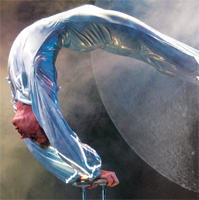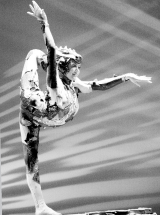home | metro santa cruz index | the arts | visual arts | preview
2007 Summer Guide:
Moscow Circus | summertime Cruz | classical festivals | summer concerts | summer theater | summer events

Photograph by Moscow Circus
The Russkies Invade!
Circus performers from Moscow are set to infiltrate Boardwalk theme park with their Godless fun and subversive folk tales
By Steve Hahn
Going to the circus is one of those bright and memorable moments in a child's life, an event that opens a whole new world of play and imagination to the young mind.
But what's in it for the adults?
Is the circus just an excuse to distract the kids or do these painted performers have something to offer the weathered theater connoisseur?
In this country, animal tricks, freaks of nature and goofy clowns have historically ruled the circus, and while adults may enjoy the show, most find more pleasure in the "grown-up" entertainment of theater, concerts, art galleries or film.
Yet that has been changing in recent decades. With sophisticated acts such as Cirque Du Soleil drawing larger crowds every year, the world of circus performing in the United States has been undergoing a transformation. The performers on the stage, or in the rings, are being taken much more seriously than in the past. Increasingly complex choreography, coordinated costumes and sets and an influx of narrative and satirical techniques borrowed from traditional Western theater have lent the performers in what was once a traveling freak show a measure of legitimacy as artists in their own right.
In Russia this trend, what Americans call the "new circus" movement, has been the norm for centuries, and this summer visitors to the Boardwalk theme park will be given a rare glimpse into the rich tradition of the Moscow Circus.
"In these times, with globalization putting a Starbucks and Home Depot all over the world, I think that telling the folk stories through this format is very attractive," says Moscow Circus artistic director Sasha Vosk. "People really respond to that. It's a combination of a show and an interaction with people of Russian culture, people from the 'other side' basically."
While the space and resource constraints of a theme park prevent the Moscow Circus from presenting their full-length show, the folk fables and tales of the circus's history in Russia will still be woven throughout the free performances.
The Boardwalk is offering the twice-daily performances as a free gift to the local community and its many summer visitors as part of its centennial celebrations, which will make the theme park a major entertainment hub for much of the summer.
"For our centennial celebration we wanted to bring in a major act and pay tribute to all of the amazing acts we've had over the years," says Boardwalk promotions manager Karley Pope.
The stories may be foreign and the circus style more theatrical, but Vosk has noticed a strong affinity between cultural tastes in Russia and the United States.
"The way we perceive things--art, stories--are very close," says Vosk, who has performed the show as far away as Indonesia. "We don't have the cultural division that you might find in other places."
In fact, the different levels of prominence attributed to the circus in Russia and America can be traced more to the politics of each country than to any larger divergent cultural trends.
While the U.S. government generally applied a hands-off, or laissez faire, attitude to the circus, the Russian government has had a hand in the development of the Russian circus since its inception.
In the 18th century, Catherine the Great ordered two circus rings built for the Englishman Charles Hughes, who had impressed her with his troupe of circus performers and trained horses. The performers were frequently visited by members of Catherine's court and other nobles, granting the circus medium equal standing with other fancies of the aristocrats such as opera and ballet.
The art form continued to grow with the centuries, incorporating Russian folk traditions along the way. By the time the Bolsheviks came to power in the 1917 Revolution, the circus was firmly established as a fixture on the national entertainment scene. But the communists would accelerate the development of the circus immensely through nationalization and heavy subsidization. The socialists prized the circus as an egalitarian art form that required little of the education and cultural sophistication demanded by other artistic mediums favored by the disposed aristocrats.
"During the Soviets, circus was king basically, it was a genre that was lucky to be promoted," says Vosk, who bypassed his mandatory military duty by performing standup comedy and circus acts for the Soviet Air Force. "It was politically correct, there was never a problem. Some performers were trying [to challenge the political order]. Clowns in Russia are very different than American clowns--they satirize people, they do minitheater, mini mise-en-scène--it can be very strong, almost like a comedic play. [But] there was no real threat, that's why it was promoted. Every big or midsize city would have a circus theater in the city center; there were no big-tops."
By the fall of the Soviets in '89, there were 70 permanent circus buildings and 50 traveling circuses in Russia, many of which visited Europe and the United States. There were also a number of state-run circus colleges. When subsidization disappeared under the free-market privatization reforms of the '90s, the number of performers and audience members within Russia dropped off significantly, according to Vosk.

Photograph by Moscow Circus
Footloose: Daria Bogdanova studied circus performing in Russia after a short career as a rhythmic gymnast and later won the highest award in the First Youth Creativity Festival, epitomizing the level of talent brought to the states by the Moscow Circus.
But the historic prominence of the circus still attracts many athletic and artistic talents to the art form, and since 1998 Vosk has been bringing the cream of the crop on his United States tour.
The Boardwalk version of this year's production will run for 45 minutes and feature contortionists, clowns, acrobats and balancing artists.
"In this show we will try to reflect different sides of the Moscow Circus," he says. "Some acts will be traditional, some will be more contemporary. We would like people to hear what contemporary Russian music sounds like, while giving them something they might not expect."
While the theme park version of the show is only half as long as the full-fledged version, Pope has done her research, and is confident that she has picked one of the best circus acts available.
"I spoke specifically with a couple of amusement parks in the Midwest that spoke very highly of the Moscow Circus show," says Pope. "I think that the Moscow Circus is something that children and adults will love--entertainment with a rich cultural tradition."
Vosk is excited to be bringing his act to another American city, both for the exposure of Russian culture it will provide and for the warm openness he has come to expect from an American audience.
"When it comes here, it's, in a way, a novelty," he says. "Audiences here are very receptive to small details. If the act is very strong, if there's a good trick, people respond to it, vs. some other countries where it's not the same. People might be polite about it and keep it until the end of the act. They may even be afraid of expressing themselves."
In Santa Cruz, there's definitely no danger of that.
The Moscow Circus plays the Santa Cruz Beach Boardwalk bandstand July 8-Aug. 16, Monday-Thursday at noon and 3pm, Sundays noon and 6pm. Free.
Send a letter to the editor about this story.
|
|
|
|
|
|